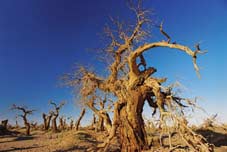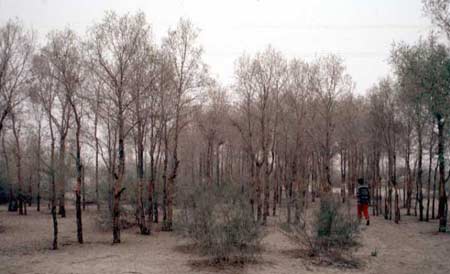In the arid desert of Northwestern China, there exists a towering tree known as the Populus diversifolia, commonly referred to as the desert poplar. Unlike typical poplar trees, the desert poplar exhibits remarkable resilience against drought, extreme climate changes, and saline soils. In the Taklamakan Desert of Xinjiang, where groundwater contains high salt concentrations, these trees thrive lushly.
 |
|
(Image: rmhb.com) |
The root system of the desert poplar can extend deeper than 10 meters, storing significant amounts of water to withstand dry conditions. Its cells have a unique ability to resist damage from salt. With a high concentration of cellular fluid, the tree can continuously absorb saline groundwater and nutrients. When branches of the desert poplar are broken, the dried ends leave behind a substance called alkali grass, which can be consumed, used to make soap, or applied as a skin treatment. A single desert poplar can produce several dozen kilograms of alkali grass each year.
The desert poplar is one of the ancient tree species, having existed on Earth for over 60 million years. It is a deciduous tree that reaches heights of 15-30 meters. Young trees and branches are densely covered with soft, fine hairs, and the large leaves are spiny while the tree is still young, taking on a linear shape. As the tree matures, the leaves become oval or egg-shaped, leading to the alternative name “different-leaved poplar.” Its flowers are red-purple and appear in needle-like forms, while the fruits are elongated, oval capsules. The desert poplar can also sprout new trees from its roots, allowing it to expand its territory.
The desert poplar grows quickly and is used as fodder for livestock. Its wood is resistant to moisture and decay, making it an excellent material for construction, especially for bridges; it can also be used to make paper or household items. The desert poplar is planted to combat sand encroachment, enhance greenery, and protect farmland.

(Image: chemsrv0)


















































